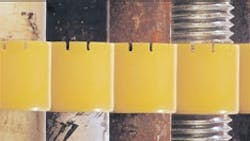Taking the guesswork out of plain bearings
Plain bearings, particularly those made of engineered polymer, offer many advantages over traditional ball bearings. They're lighter, less expensive, self-lubricating, and able to withstand corrosive environments. Although many engineers have discovered this for themselves – contributing to a growing number of applications – there are still plenty of others who've yet to take advantage of this new technology for no other reason than a lack of familiarity.
Suppose you need to support a shaft and you're narrowing down your bearing choices. If you're considering ball bearings, you know you'll be able to find all kinds of lifeexpectancy data for various speeds, loads, and temperatures. There is little such information, however, for plain bearings. The reason has nothing to do with product maturity, but a fundamental design difference.
Ball bearings are "closed" designs since all moving parts are selected and controlled by the bearing manufacturer. Plain bearings, on the other hand, are "open" designs because the user, not the bearing maker, specifies the shaft running through the bearing. Because of this it's not possible to accurately project lifetime and performance for the general case.
A closer look at ball bearings reveals an outer race, an inner race, and the rolling elements, or balls, themselves. The shaft is pressed onto the inner race, which turns against the balls and outer race. Motion system designers who use these bearings can rely on the performance test data, regardless of the shaft material they intend to use.
Shafting has a big influence, however, on the performance and life of a plain bearing. The life expectancy of any plain bearing surface will vary with the hardness, finish, and general compatibility of the shaft material, even if all other parameters (load, speed, and temperature) remain the same.
What's more, changing the hardness or surface finish of the shaft can make a huge difference, or it could have no effect at all. For this reason, there is relatively little life-expectancy data on plain bearings, and what's out there is valid only for specific bearings and conditions.
Your best bet if you're considering polymer plain bearings is to check with the manufacturer. Many have databases that contain information on a variety of mating surfaces, giving reasonable life-expectancies for standard applications.
If you require absolute data, there is one option. It's a "closed" polymer bearing design that works with any mating surface. The inner sleeve of the rotary bearing acts as the gliding surface, such that the coefficient of friction and specific wear properties do not depend on shaft material.
The coefficient of friction, under loads of up to 725 psi, is between 0.12 and 0.2. By comparison, the friction coefficient for steel and polymer is between 0.08 and 0.3.
Carsten Blase is vice president of igus Inc., East Providence, R.I.
